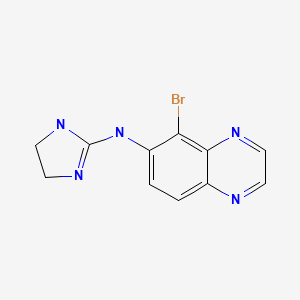CASRN: 59803-98-4

Drug Levels and Effects
Summary of Use during Lactation
Limited information indicates that maternal use of brimonidine 0.2% ophthalmic drops do not adversely affect their nursing infants. However, some authors warn of possible CNS depression, apnea, lethargy, bradycardia with brimonidine and recommend against its use during breastfeeding.[1-3] To substantially diminish the amount of drug that reaches the breastmilk after using eye drops, place pressure over the tear duct by the corner of the eye for 1 minute or more, then remove the excess solution with an absorbent tissue.
Topical brimonidine gel used to treat rosacea has not been studied during breastfeeding. It is unlikely that the topical gel would affect the breastfed infant, but the manufacturer states that it should not be used during nursing. Until more data are available, an alternative topical agent might be preferred
Drug Levels
Maternal Levels. Relevant published information was not found as of the revision date.
Infant Levels. Relevant published information was not found as of the revision date.
Effects in Breastfed Infants
A woman used brimonidine 0.2%, timolol gel-forming solution 0.5%, dipivefrin 0.2%, and dorzolamide 0.5% drops for glaucoma while nursing a newborn. The frequency of medication use and extent of nursing were not stated. All medications were given immediately after nursing with punctal occlusion of the tear duct. The infant's vital signs were closely monitored with no signs of bradycardia or apnea.[4]
A woman was using ophthalmic drops containing 0.5% timolol and 0.2% brimonidine twice daily in the right eye for 6 months. During this time, she breastfed her infant (extent not stated) apparently without harm to her infant.[5]
Effects on Lactation and Breastmilk
Relevant published information was not found as of the revision date.
Alternate Drugs to Consider
(Topical for Rosacea) Azelaic Acid; Metronidazole
References
- 1.
- Belkin A, Chen T, DeOliveria AR, et al. A practical guide to the pregnant and breastfeeding patient with glaucoma. Ophthalmol Glaucoma. 2020;3:79–89. [PubMed: 32672600]
- 2.
- Blumen-Ohana E, Sellem E. J Fr Ophtalmol. 2020;43:63–6. [Pregnancy & glaucoma: SFO-SFG recommendations] [PubMed: 31813552]
- 3.
- Kumari R, Saha BC, Onkar A, et al. Management of glaucoma in pregnancy - balancing safety with efficacy. Ther Adv Ophthalmol. 2021;13:25158414211022876. [PMC free article: PMC8243098] [PubMed: 34263134]
- 4.
- Johnson SM, Martínez M, Freedman S. Management of glaucoma in pregnancy and lactation. Surv Ophthalmol. 2001;45:449–54. [PubMed: 11274697]
- 5.
- Madadi P, Koren G, Freeman DJ, et al. Timolol concentrations in breast milk of a woman treated for glaucoma: Calculation of neonatal exposure. J Glaucoma. 2008;17:329–31. [PubMed: 18552619]
Substance Identification
Substance Name
Brimonidine
CAS Registry Number
59803-98-4
Drug Class
Breast Feeding
Lactation
Milk, Human
Adrenergic alpha-2 Receptor Agonists
Antiglaucoma Agents
Disclaimer: Information presented in this database is not meant as a substitute for professional judgment. You should consult your healthcare provider for breastfeeding advice related to your particular situation. The U.S. government does not warrant or assume any liability or responsibility for the accuracy or completeness of the information on this Site.
Publication Details
Publication History
Last Revision: April 18, 2022.
Copyright
Attribution Statement: LactMed is a registered trademark of the U.S. Department of Health and Human Services.
Publisher
National Institute of Child Health and Human Development, Bethesda (MD)
NLM Citation
Drugs and Lactation Database (LactMed®) [Internet]. Bethesda (MD): National Institute of Child Health and Human Development; 2006-. Brimonidine. [Updated 2022 Apr 18].